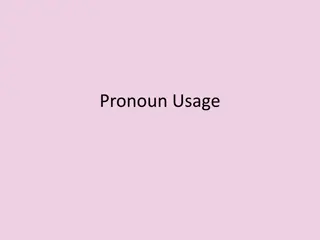Understanding Pronouns and Their Importance in Communication
Pronouns are essential in language, serving to replace nouns and avoid repetition. They include third-person singular forms like "he," "she," and "they." By using pronouns correctly and respecting others' pronouns, we show understanding and promote inclusivity in communication.
Download Presentation

Please find below an Image/Link to download the presentation.
The content on the website is provided AS IS for your information and personal use only. It may not be sold, licensed, or shared on other websites without obtaining consent from the author. Download presentation by click this link. If you encounter any issues during the download, it is possible that the publisher has removed the file from their server.
E N D
Presentation Transcript
What about pronouns? They, he, she OH MY!
A brief lesson in grammar: Let s take it ALL the way back to elementary school English class! Grammatically, pronouns are words that we use in place of nouns, to avoid repeating those nouns. Third person singular pronouns include: he, him, his, she, her, hers.
Bauer, E. (2013). Sexuality and gender activism: Gender-neutral pronouns. Retrieved from https://apps.carleton.edu/student/orgs/saga/pronouns/
Pronouns are: Often automatic - and - Based on our perceptions of others genders
Why do pronouns matter? Do pronouns matter to you personally? Why or why not? When you use a pronoun to refer to someone, what are you saying about them?
A little Pronoun Etiquette: If you make a mistake, correct yourself. Going on as if it did not happen is actually less respectful than making the correction. If someone else makes a mistake, correct them. If you aren t sure of a person s pronoun, ask. One way to do this is by sharing your own. Spade, D. (2011). Some very basic tips for making higher education more accessible to trans students and rethinking how we talk about gendered bodies. Radical Teacher, 92 (pp. 57-62).
Pronouns Q&A Additional References: Shlasko, D. (2014). Trans* ally workbook: Getting pronouns right & what it teaches us about gender. Think Again Training and Consultation.























